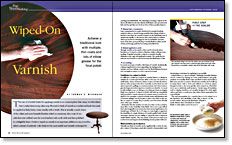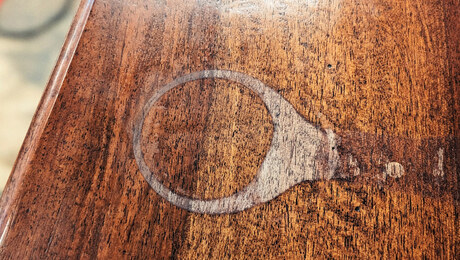Wiped-On Varnish
Achieve a traditional look with multiple, thin coats and lots of elbow grease for the final polish
Synopsis: Thomas E. Wisshack writes that some of the oldest and most beautiful finishes relied on numerous, thin coats of varnish that were rubbed on with a soft cloth and then polished to a delightful shine. This method features minimal dust contamination, minimal application marks, and less buildup. Wisshack identifies candidates for a wiped-on finish, and says that virtually any kind of varnish can be applied with a cloth. He explains and demonstrates each step, starting with the sealer, followed by coats of varnish, and then leveling. He uses a ball of cotton cloth and cheesecloth to apply the varnish. Wisshack troubleshoots possible pitfalls and offers advice on how many coats to apply before detailing the best way to approach the final rub.
The use of a bristle brush for applying varnish is so commonplace that many woodworkers don’t realize there is any other way. We tend to think of varnish as a traditional finish that must be applied in fairly heavy coats, usually with a brush. This is actually a myth. Some of the oldest and most beautiful finishes relied on numerous, thin coats of varnish that were rubbed onto the wood surface with a soft cloth and then polished to a delightful shine. I believe wiped-on varnish is an important addition to any wood finisher’s arsenal of methods. I also think it’s the most useful and versatile technique for creating a beautiful finish. The advantages of using a wiped-on finish are all related to the fact that the individual coats are extremely thin and dry quickly. Let’s look at a few of these positive features.
Minimal dust contamination
Dust contamination is a major drawback for people brushing varnish; it dries so slowly foreign particles have plenty of time to land in it. But when the varnish is wiped on, the individual coats of varnish dry rapidly, so dirt doesn’t have much chance to adhere. This is an enormous advantage for the wood finisher, because most of the time spent perfecting a varnish finish is a direct result of dust and foreign particles becoming embedded in it.
Minimal application marks
Though varnish can be made to flow and level nicely when brushed on, it’s hard to achieve a flawless surface without some sanding. If applied properly, a wiped-on varnish virtually eliminates runs, sags and application marks. The marks that do exist are much easier to remove because the finish layer is thin.
Less buildup
It’s rarely necessary to build a thick layer of varnish. Aesthetically, a thinner application is more appealing. By wiping on the varnish, you have infinite control over the final thickness because you can apply as many or as few coats as you want.
From Fine Woodworking #132
For the full article, download the PDF below:
Fine Woodworking Recommended Products

Bumblechutes Bee’Nooba Wax

Osmo Polyx-Oil

Veritas Wheel Marking Gauge






















Log in or create an account to post a comment.
Sign up Log in